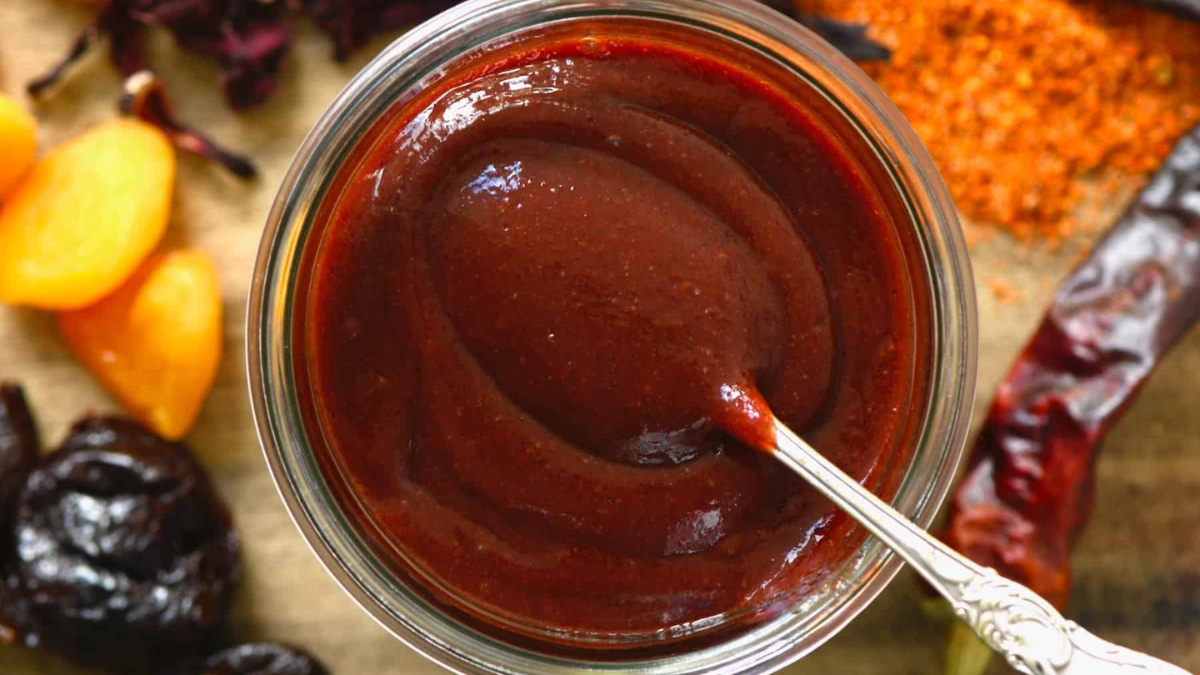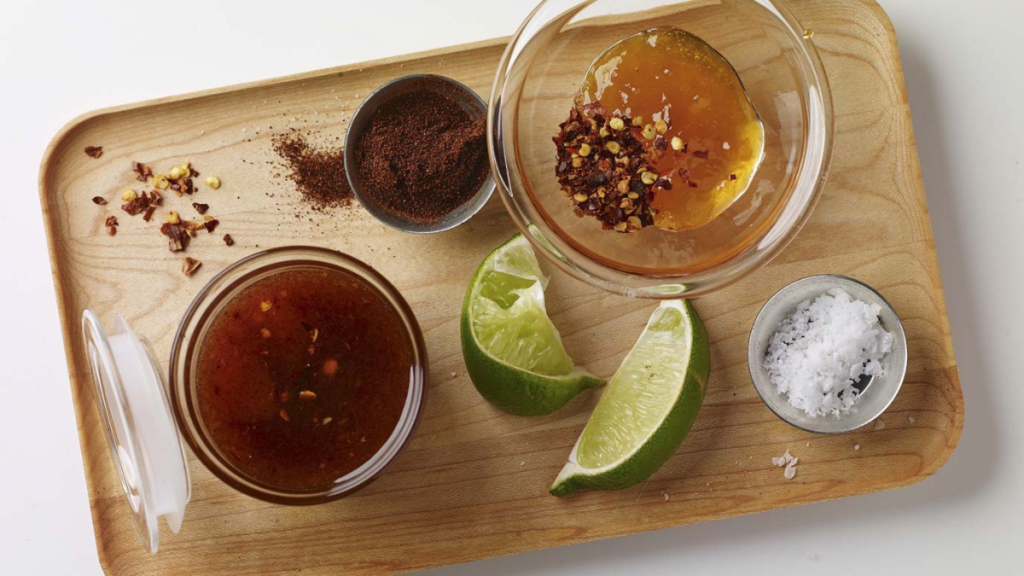To quickly prepare chamoy, you only need eight really simple and easy-to-find items to make this savory sauce! This recipe for chamoy is quick, easy, flavorful, and adaptable in various ways. It features the ideal proportion of spices and a blend of sweet, sour, and salty flavors. The best part about making your chamoy sauce is its adaptability. You can use it on everything! This recipe will soon become your go-to one for handmade chamoy.
You can season everything with chamoy if you want to! It works as a spread, a dip, or even the primary sauce ingredient in many well-liked Mexican-themed dishes and recipes. You might try including it in some of your preferred recipes as well. Additionally, you can have this Mexican chamoy with fresh produce like watermelon, pineapple, avocado, or other fruits and vegetables.
What is Chamoy?
Knowing how to use chamoy requires understanding what it is. This savory sauce is well-liked in Mexico and frequently used in Mexican food. It comes in various forms, from a liquid to a paste that can be obtained in bottles or jars. Traditionally, the brine from saladitos is used to make it (dried and salted plums or apricots). Pickled fruit, chiles, and lime juice are just a few savory elements that a good chamoy sauce recipe will make sure to use.
Mangonadas, also known as mango chamades, are a delicious example of a chimney. It can be used to add sweetness and spice to cuisine, but it also tastes fantastic and is highly addictive when combined with salty foods like chips, snacks, and nuts. The resulting sauce’s flavors include sweet, salty, spicy, and sour, and it can be drizzled over fresh fruit, vegetables, and perhaps even certain candies as a topping or used as a chamoy dip.
Is Chamoy Spicy?
If you’re wondering what chamoy tastes like, there isn’t simply one phrase to describe it because the sauce is a flavor explosion. In only one bite, there will be many different flavors to experience. The chamoy sauce produces a balance of sweetness with a touch of salty and spice when it is added to fruit.
Now you see why everyone adores chamoy recipes since the components permit flavor variations! When chamoy paste is added to avocados, the flavor is significantly altered, with more emphasis on the heat and spice and less on the sweetness. Additionally, if you use this tajin chamoy recipe as a dip for nuts or chips, it will work incredibly well with the salty textures and have a saltier flavor profile than a spicy or sweet one.
How to Make Chamoy?
Making your own is quite simple! Finding the ideal ingredient ratios to suit your taste is the key. Start by heating the 6 cups of water and the rest of the ingredients in a medium saucepan. Never add the lime juice at this time. Heat is reduced to low after bringing all ingredients to a boil. For 30 minutes, simmer. Remove from heat and allow it to cool completely before mixing—10 minutes or so.
Blend everything in a blender, being sure to include the lime juice. If you desire a more liquid consistency, you can check the liquid consistency and add a few more tablespoons of water. Instead of using red food coloring, this recipe uses dark prunes, which give it a brownish hue rather than a red one.
Ingredients
- 1 cup of 6.6 oz. dried apricots
- 1 cup of 6.2 oz. prunes
- 1 cup of 1 oz. dried hibiscus flower
- 1/4 cup sugar, 2 oz.
- One lime
- Salt, 1/8 teaspoon
- 2-cups of water
- 1/3 cup of chili powder or tajin
- Two medium chilies, each weighing 0.1 oz., optionally for more heat
Equipment
- Blender/Food processor
Instructions
- In a saucepan, combine the dried fruit, hibiscus flowers, water, and dried chiles (if using). Once at a boil, lower the heat and simmer for 15 to 20 minutes.
- Take the food off the stove and let it cool for ten to fifteen minutes. The sugar can be added now to dissolve more readily in the heated liquid.
- Blend the contents in a blender until it has reached the desired consistency—remix after adding the lime, salt, and tajin.
- To remove the pulp, pass through a fine-mesh sieve.
- Store it in the freezer or refrigerator in an airtight glass jar for up to two months (up to 6 months).
How do I Store Chamoy?
All that’s left to do is cook, drain, and store the sauce in an airtight container to keep it cool in the refrigerator (up to 2 months). That’s all there is to it. You can freeze the sauce for longer storage. I advise chilling it in ice cube trays beforehand. Transfer the sauce cubes to a freezer-safe bag after they have frozen. For up to six months, store in the freezer.
Make your homemade recipe to save time searching for “chamoy near me.” It’s incredibly easy to keep it on hand and prepared for use whenever the urge arises. The shelf life of our chamoy is one (1) year. You can keep chamoy and gummies at room temperature but keep them away from extreme heat.
Gummies shouldn’t be kept in the fridge. Chamoy is an incredibly tasty condiment that has the ideal ratio of sweet, salty, sour, and spicy flavors. The most popular way to eat chamoy, which is from Mexico, is with dessert.
If you wander the streets of Mexico City, you will undoubtedly come across a fruit stall offering chamoy over fresh fruit. We believe that chamoy, a lesser-known spice, belongs in your kitchen, especially if you enjoy Mexican food. However, once you have loaded up on chamoy, you will need to respond to today’s query: Does chamoy go bad?
What do you Eat Chamoy with?
When it comes to mixing your homemade chamois with food, you have a lot of alternatives. Please enjoy it with fresh fruit, vegetables, or even a garnish for tortilla chips and chips. It’s a wonderful enhancement to veggie plates. Prepare tamarind, jicama, cucumbers, or carrots, and top them with the sauce.
You may also serve it with fruit like watermelon, pineapple, apples, fresh mango, and pineapple. The chamoy and tajin sauce can either be served as a chamoy dip on the side or drizzled on top of your chopped fruit. Additionally, you can drizzle it over ice cream, popsicles, and paletas. Make a cool mango chamoyada as well, of course (mangonada).
Chamoy is most frequently utilized to flavor fresh fruits and vegetables. Slices of mango, pineapple, jicama, watermelon, and avocado are frequently drizzled. Another typical Mexican snack is to roll an apple in chamoy paste and serve it whole, almost like a candy apple.
Chamoy is frequently used for nachos, tacos, roasted vegetables, steak, and chili. It can also be used to add a sweet flavor to savory foods. Tostilocos, a traditional street snack from Mexico, is a blend of peanuts, jicama, cucumber, lime, curios, or dried pig skin, spiced with chamoy. Chamoy can also be drizzled over food as desired and used similarly to a hot sauce.
What does it Taste Like?
Chamoy tastes similar to an Asian sweet and sour sauce on its own, but with greater heat and a richer tang. This dish’s distinctive sweet-and-spicy flavor complements light fruits and vegetables, cheeses, bean dishes, and dishes with other beans. The fruit’s sweetness helps to temper the burn, and while it is spicy, it doesn’t have a burning heat. When eating chamoy in candy, the sugary flavor is more noticeable, and a little more salt is frequently added to the dish.
There are numerous chamoy brands available, and they are all quite comparable. The most well-known chamoy sauce bottles are Tajn Chamoy, Salsas Castillo, and Chilerito Chamoy. Though it’s less common, chamoy can also be obtained in paste form. Due to its use as a spice to cover apples, the paste form of chamoy is occasionally called “apple paste.” The Miguelito brand and the Lucas Chamoy variety of powdered chamoy work well for rimming bloody marys or dusting on fruit.
What is a Substitute for Chamoy Sauce?
The only ingredients required are dried plums, soy sauce, sugar, rice vinegar, garlic, chili powder, cloves, and ginger. Add some lime juice and honey to make it more resemble Chamoy sauce. It goes well with grilled chicken, roast pork, stir-fries, and as a dipping sauce. It pairs wonderfully with aged cheese! It is a well-known condiment prepared from dried fruit like apricot, mango, or plums (or a combination of these), chile powder, salt, sugar, and a tiny bit of citrus juice. Chamoy would be the dish that best captured the essence of Mexican cuisine. Chamoy has a fruity chile sauce flavor.
All the flavors—salty, spicy, sweet, and sour—are present to their fullest extent. Even though chamoy and Tajin are frequently combined in recipes, they are completely different substances. As you’ve learned, chamoy is a condiment produced from fruit that has been pickled. Tajin is the brand name for a chile-lime seasoning from Mexico. Chamoy can take many different shapes in Mexico. Originally, it was a salted dried fruit (Saladino), traditionally made from the ume plum, or prunus mume, a small tart apricot. However, other common fruits like tamarind pods and sour green mangoes exist.
Conclusion
Make your chamoy with this easy approach! The most popular seasoning in Mexico is used in a range of foods, including fruit, drinks, snacks, and even main courses. To impress your guests, serve refreshing Mexican cocktails with homemade chamoy sprinkled, mangonada, chicharrones de harina, over your favorite fruit, or even on the edge of a glass. Apricot, mango, or plums (or a combination of these), chile powder, salt, sugar, and a tiny bit of citrus juice are used to make this somewhat well-known condiment.
The perfect mix of tastes! This Mexican sauce is becoming more and more well-liked both domestically and abroad. However, it has been a common sauce in Mexico since the early 1970s. If you visit Mexico, you must see Chamoy offered by every food vendor on the street! It features tangy, salty, sweet, sour, and spicy flavors.

